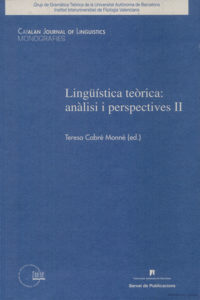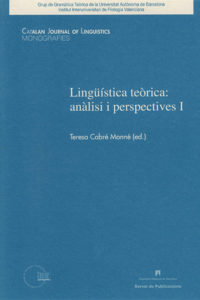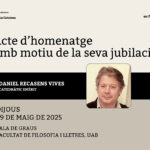20 juny, 2016
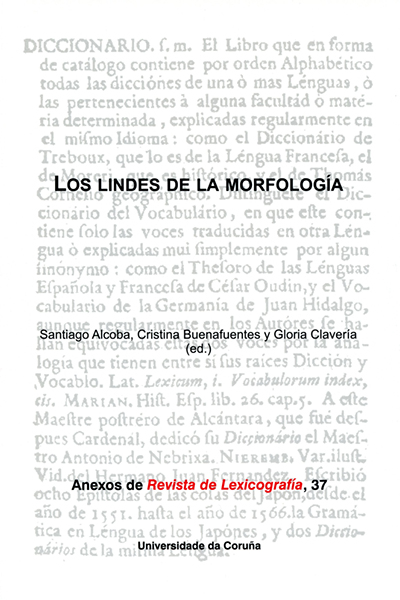
Autors:
Santiago Alcoba, Cristina Buenafuentes y Gloria Clavería (eds.)
Títol:
Los lindes de la morfologíaEditorial: Universidade da Coruña
Data de publicació: 2016
Pàgines: 220ISBN13: 978-84-9749-638-4
Més informacióLa obra Los lindes de la morfología reúne diversos estudios en los que, desde distintas perspectivas, se analiza el puesto de la morfología dentro del sistema lingüístico y la naturaleza de sus límites, siempre complejos.
La primera parte está constituida por cinco artículos que exploran las conexiones de la morfología con otros componentes de la gramática: así, el estudio de B. Camus se enfrenta a la naturaleza del cambio morfológico desde las relaciones que la morfología sostiene con la fonología y la sintaxis; el vínculo de la morfología con la sintaxis se examina en los trabajos de C. Picallo y M. Á. Cano; la interfaz morfología y fonología es el objetivo fundamental del estudio de M.ª R. Lloret; y el tratamiento de la morfología derivativa en el diccionario es analizado en el capítulo de M. Torres.
La segunda parte tiene carácter misceláneo y recoge una serie de trabajos que, si bien muchos de ellos transitan también por los lindes de la morfología, giran en torno a temas variados como los problemas de demarcación en morfología y sintaxis (E. Felíu), la relación morfología y E/LE (N. Marcos), la naturaleza sintáctica de las palabras que presentan sintagmas como modificador (B. Marqueta), el origen de los morfemas (J. L. Mendívil) o el estudio diacrónico de los parasintéticos en des– (M. Sinková).
La obra se cierra, a modo de homenaje, con una semblanza académica del profesor Santiago Alcoba Rueda.
20 juny, 2016
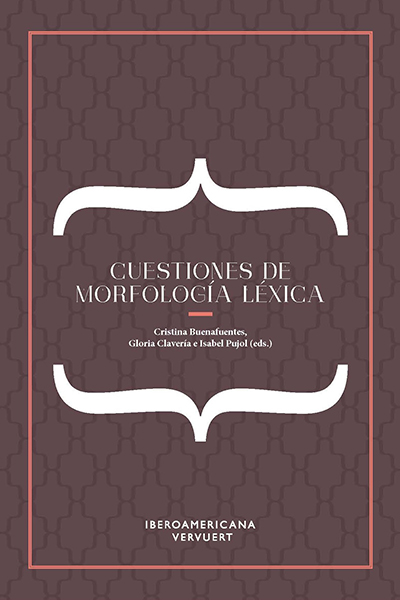
Autors:
Cristina Buenafuentes, Gloria Clavería, Isabel Pujol (eds.).
Títol:
Cuestiones de morfología léxicaEditorial: Iberoamericana Vervuert
Data de publicació: 2016
Pàgines: 228ISBN13: 978-84-8489-968-6
El contenido de esta obra refleja algunos de los focos de debate de la investigación sobre morfología léxica en la actualidad. Algunos de ellos se derivan de las relaciones entre los distintos procesos de formación de palabras y otros surgen de la interdependencia entre la morfología y otros componentes de la gramática. Reúne una selección de trabajos sobre diferentes temas, tales como: el concepto de paresíntesis, el análisis de la competencia de sufijos, o la interrelación de la morfología con otros componentes de la gramática, como la sintaxis o la semántica.
Las diferentes contribuciones han sido elaboradas por reconocidos investigadores en el terreno de la morfología del español. Los textos se articulan en torno a las investigaciones que se presentaron en el “Ciclo de conferencias sobre morfología léxica” celebrado en la Universitat Autònoma de Barcelona y en la Universitat de Girona desde octubre de 2013 hasta enero de 2014. El ciclo surgió de la necesidad de profundizar en distintos aspectos de la formación de palabras, motivada por el desarrollo del proyecto, el cual tenía entre sus objetivos el análisis de las palabras complejas en la historia del español.
23 maig, 2020
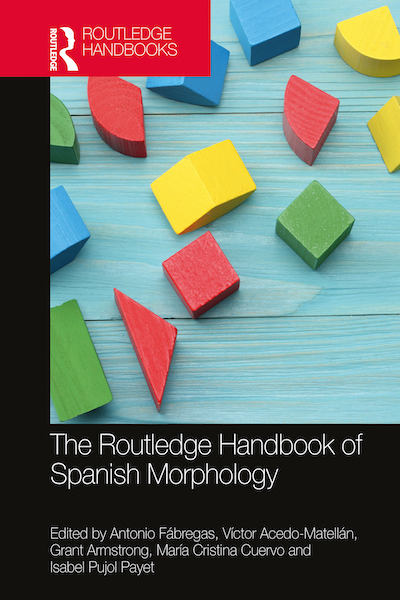
Autors:
Cristina Buenafuentes de la Mata
Títol:
Main compounding types in Spanish: Synchronic issues. Dins Fábregas, Acedo-Matellán, Armstrong, Cuervo, Pujol (eds.) "The Routledge Handbook of Spanish Morphology"Editorial: Taylor & Francis Group
Data de publicació: Maig del 2021
ISBN13: 9780429318191
The Routledge Handbook of Spanish Morphologypresents a state-of-the-art, detailed and exhaustive overview of all aspects of Spanish morphology, paying equal attention to the empirical complexities of the morphological system and the theoretical issues that they raise.
As such, this handbook is relevant both for those interested in the facts of Spanish morphology and those interested in general morphology that want to explore how the Spanish facts illuminate our understanding of human language and current theories of morphology.
This volume is also unique in its extent and coverage. Written by an international team of leading experts in the field, it contains 42 chapters divided into four sections, covering all synchronic and diachronic aspects of Spanish morphology, including inflection; derivation; compounding and other processes of word formation; the interaction of morphology with other modules of grammar and the role of morphology in language acquisition, psycholinguistics and language teaching.
14 octubre, 2004

Autors:
Teresa Cabré (ed.)
Títol:
Lingüística teòrica: anàlisi i perspectives IEditorial: Universitat Autonònoma de Barcelona, Servei de Publicacions
Col·lecció: Monografies Catalan Journal of Linguistics #2Data de publicació: 2004
Pàgines: 259ISBN13: 8449023742
Aquesta publicació representa un pas endavant en la voluntat de deixar constància dels resultats de les reunions anuals de la Xarxa Temàtica de Lingüística Teòrica que coordina el Grup de Gramàtica Teòrica de la Universitat Autònoma de Barcelona.
El projecte de Xarxa Temàtica de Lingüística Teòrica (XT2002 0036) de la Generalitat de Catalunya té com a punt central l’organització d’una reunió cientí- fica anual en forma de congrés que aplega els especialistes en lingüística dels grups de recerca procedents de diferents universitats dels Països Catalans, així com del País Basc i de Madrid. El congrés consisteix en la presentació de quatre temes inter- disciplinars d’actualitat científica en l’àmbit de la lingüística a càrrec d’especia- listes de reconegut nivell internacional, amb dos comentaristes cadascun, encarre- gats de marcar les línies de debat de cada tema.
El volum que presentem conté els resultats de la primera reunió científica, que es va celebrar el 21 de novembre del 2003. Aquesta jornada va tractar quatre temes: lèxic i lexicografia, llengües de signes, adquisició fonològica i semàntica oracional. Com es pot veure, tant l’amplitud dels temes com la varietat d’enfocaments teòri- co-aplicats fan de la Xarxa Temàtica de Lingüística Teòrica el fòrum de la investigació en lingüística més representatiu dins l’Estat espanyol.
Portada, crèdit i taula de continguts
Presentació
Bosque, Ignacio (Universidad Complutense de Madrid e Instituto Ortega y Gasset)
La direccionalidad en los diccionarios combinatorios y el problema de la selección léxica.
Lingüística Teòrica: analisi i perspectives, I, pp. 13-58
Espinal, M. Teresa (Universitat Autònoma de Barcelona)
Sobre la proposta lexicogràfica del Diccionario de restricciones léxicas.
Lingüística Teòrica: analisi i perspectives, I, pp. 59-65
Villalba, Xavier (Universitat Autònoma de Barcelona)
Les combinacions lèxiques i el sentit figurat.
Lingüística Teòrica: analisi i perspectives, I, pp. 67-74
Quer, Josep (ICREA i Universitat Autònoma de Barcelona)
Efectes de la modalitat de les llengües de signer en la teoria sintàctica: problemas i perspectives.
Lingüística Teòrica: analisi i perspectives, I, pp. 77-97
Picallo, M. Carme (Universitat Autònoma de Barcelona)
Universals lingüístics i generalitzacions tipològiques.
Lingüística Teòrica: analisi i perspectives, I, pp. 99-102
Mascaró, Joan (Universitat Autònoma de Barcelona)
Llengües de signes, llengües orals i interfície fonètica.
Lingüística Teòrica: analisi i perspectives, I, pp. 103-105
Lleó, Conxita (Universitat d’Hamburg)
La recerca de l’adquisició fonològica de la primera llengua: dels segments a la prosodia.
Lingüística Teòrica: analisi i perspectives, I, pp. 109-139
Prieto, Pilar (ICREA i Universitat Autònoma de Barcelona)
Circumscripció prosòdica i adquisició fonològica.
Lingüística Teòrica: analisi i perspectives, I, pp. 141-147
Elorrieta, Gorka (Universidad del País Vasco y LEHIA)
Marco teórico y adquisición fonológica.
Lingüística Teòrica: analisi i perspectives, I, pp. 149-155
Brucart, José M. (Universitat Autònoma de Barcelona)
Entre el borrado y la reconstrucción: nuevos enfoques en el tratamiento gramatical de la elipsis.
Lingüística Teòrica: analisi i perspectives, I, pp. 159-189
Títols de la col·lecció / Also in this series:
14 maig, 2007
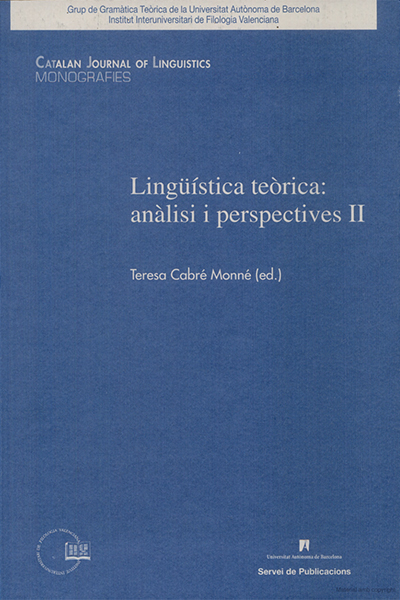
Autors:
Teresa Cabré (ed.)
Títol:
Lingüística Teòrica: anàlisi i perspectives IIEditorial: Universitat Autonònoma de Barcelona, Servei de Publicacions
Col·lecció: Monografies Catalan Journal of Linguistics #3Data de publicació: 2007
Pàgines: 235ISBN13: 9788449025303
Més informacióLingüística Teòrica: anàlisi i perspectives II és el resultat de la segona reunió científica de la Xarxa Temàtica de Lingüística Teòrica de la Generalitat de Catalunya (XT2002 0036), que es va celebrar el 26 de novembre del 2004.
Aquesta jornada va tractar quatre temes: gramaticalització i canvi lingüístic, aspectes de la interfície fonologia-morfologia, primitius lèxics i semàntica lèxica, i tècniques de neuroimatge aplicades a l'estudi de la llengua. Aquesta xarxa temàtica congrega els especialistes en lingüística dels grups de recerca procedents de diferents universitats dels Països Catalans, així com del País Basc i de Madrid. Tant l'amplitud dels temes com la varietat d'enfocaments teòrico-aplicats fan de la Xarxa Temàtica de Lingüística Teòrica un dels fòrums sobre investigació en lingüística més representatius dins l'Estat espanyol.
Títols de la col·lecció / Also in this series:






